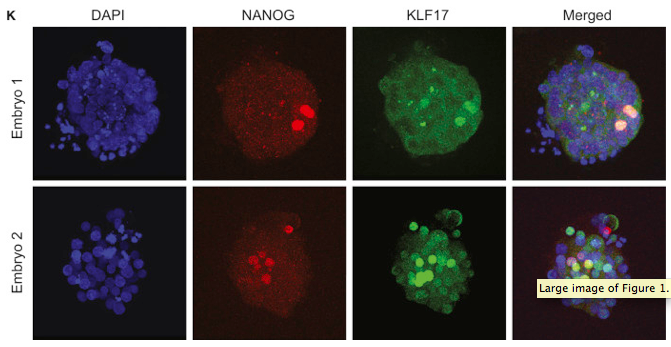|
|||||||||||||||
|

CLICK ON weeks 0 - 40 and follow along every 2 weeks of fetal development
|
|||||||||||||||||||||||||||
A first: earliest stages of human stem cell lines As well as a potential source of stem cells for use in regenerative medicine, this new technique could open up avenues for research into disorders such as Down's syndrome. The ability to create naïve stem cells from mouse embryos has been possible for over thirty years. The technique was developed by Sir Martin Evans and Professor Matthew Kaufman during their time at Cambridge University in the UK. But, this is the first time naïve stem cells have been made from human embryos. Human pluripotent stem cells considered for use in regenerative medicine or biomedical research to date come from two sources: (1) embryonic stem cells, from fertilised egg cells discarded from IVF procedures; and (2) induced pluripotent stem cells, or skin cells reprogrammed into a pluripotent form. However, both cell types are already "primed" to differentiate into specific cell types.
When an egg cell is fertilised by a sperm, it divides and begins to replicate cells. Around day five, embryonic cells cluster together to form a structure called the 'blastocyst', just before implanting into the uterus. The blastocyst is made up of three cell types: one that will develop into the placenta and allow the embryo to attach to the womb; cells that form the 'yolk sac' and provide nutrients to the developing fetus; and 'epiblast' cells or the naïve cells that will develop into tissues of the body. Research just published in the journal Stem Cell Reports, scientists from the Wellcome Trust-Medical Research Council within the Cambridge Stem Cell Institute, managed to remove cells from the blastocyst at around day six and grow them individually in culture. By separating the cells, they effectively stopped them from interacting with each other, preventing each cell from being sent down a particular path of development.
As naïve pluripotent stem cells have no developmental restrictions, they may have therapeutic use in regenerative medicine to treat devastating conditions. Particularly those medical conditions affecting organs and tissues with poor regenerative capacity, such as the heart, brain and pancreas.
Ordinarily, each body cell contains 46 chromosomes (23 in each sex cell), but some children are born with additional copies. Children with Down's syndrome are born with three copies of chromosome 21. Explains Dr Nichols: "Even in many 'normal' early-stage embryos, we find several cells with an abnormal number of chromosomes. Because we can separate the cells and culture them individually, we could potentially generate 'healthy' as opposed to 'affected' cell lines. This would allow us to generate and compare tissues of two models, one 'healthy' and one that is genetically-identical other than the surplus chromosome. This could provide new insights into conditions such as Down's syndrome." Abstract The research was supported by the Medical Research Council, Biotechnology and Biological Sciences Research Council, Swiss National Science Foundation and the Wellcome Trust. Reference: Guo, G et al. Naïve pluripotent stem cells derived directly from isolated cells of the human inner cell mass; Stem Cell Reports; 3 March 2016. |
Mar 10, 2016 Fetal Timeline Maternal Timeline News News Archive
|
|||||||||||||||||||||||||||


